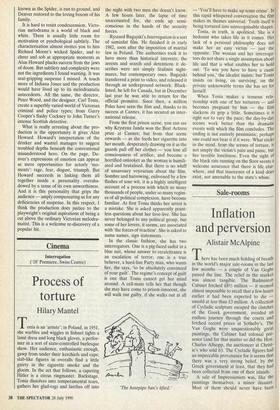Sale-rooms
Inflation and perversion
Alistair McAlpine
There has been much holding of breath in the world's major sale-rooms in the last few months — a couple of Van Goghs passed the line. The relief in the market was almost tangible. The Badminton Cabinet fetched 01/2 million — it seemed almost impossible to recall that a few hours earlier it had been expected to die — unsold at less than £3 million. A collection of Cycladic sculpture escaped the clutches of the Greek government, avoided an endless journey through the courts and fetched record prices at Sotheby's. The Van Goghs were unquestionably great paintings, the Cabinet had colossal pre- sence (and for that matter so did the Hon. Charles Allsopp, the auctioneer at Christ- ie's who sold it). The Cycladic figures had an impeccable provenance for it seems that there was a very strong belief, by the Greek government at least, that they had been collected from one of their islands.
= A sale of Impressionists was, like the paintings themselves, a minor disaster. Most of them should never have been released from the captivity of the artist's studio in the first place; certainly nobody interested in owning a work of art could possibly have wanted one of these. There are many reasons why people buy paintings — investment is one of them. For people interested in money, a real opportunity was to be had when Phillips sold two blocks of bank bonds — 6 per cent Planters bank bonds, 1831-3, and 5 per cent Mississippi Union bank bonds, 1838 – originally issued to English and Scottish investors, repay- able in London. There is about as much chance of the investors in these bonds getting their money back as the investors in those awful Impressionist paintings, and the bonds are a lot prettier.
Inflation, still hovering in the back- ground, from time to time spurs people into goods and out of money. The Antique Porcelain Company, which operates both in New York and in impressive premises in Bond Street, was founded by a German lawyer who, selling a building in the great inflation, found that the next day his money bought barely a box of matches. In Shanghai, in 1948, the banks changed their money into rice every night and back to currency the following morning.
However, the market is perverse. It is quite clear that if an object has quality, presence and provenance it will fetch an exceedingly high price. If it has any one of those it will probably fetch a high price. But it also needs to be fresh. The object can have been exhibited many times and it improves in value, but offered twice in a short space of time in the sale-room, then beware. The auction rooms are strange places. A friend of mine, on offering the surplus part of his cellar for sale, was surprised to find that, amongst his Latour 1949 and Lafite 1945, the auctioneers had marked the Mouton 1958 as likely to fetch an exceedingly high price (for the benefit of teetotallers, the 1958 vintage was with- out question the worst of the whole cen- tury). Why on earth would they make this mistake, he asked. 'In 1958,' the auc- tioneer replied, 'Château Mouton Roth- schild made very little wine, so the label is very scarce — it's a drawing by Salvador Dali, you know.' This wine, apparently, is for looking at, not for drinking. Strangely, when you take the wine out of the bottle, the label becomes worth a lot less.
Experts, and for that matter amateurs, debate the rise and fall of the art market and will do, I suspect, for some time to come. But the real market is not about whether a Van Gogh fetches 25 per cent less than expected. The test of the market is really in Victorian birdcages — if they drop 25 per cent, thousands of dealers all over the world are in deep trouble.
Meanwhile, as the auction houses move on to another season, the sale-rooms are still the greatest of casinos. But the days of the amateur, gambling on art in the rooms, are drawing to a close — and the days of a real market have begun.



















































 Previous page
Previous page